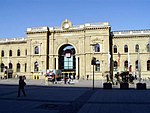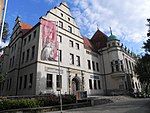Otto von Guericke University Magdeburg

The Otto-von-Guericke University Magdeburg (German pronunciation: [ˈɔtoː fɔn ˈɡeːʁɪkə]) (OvGU) was founded in 1993, making it one of the youngest universities in Germany. The university is located in Magdeburg, the Capital city of Saxony-Anhalt and has about 13.000 students in nine faculties. According to the Scopus database there are around 32.900 papers published in international journals from the University.It was named after the physicist and former mayor of Magdeburg Otto von Guericke, famous for his experiments with the Magdeburg hemispheres. The University had three forerunner institutions. These were the Technical University, the Pedagogical college and the Medical Academy, the first of which was established around 1953. They were amalgamated to the Otto-von-Guericke University in 1993.
Excerpt from the Wikipedia article Otto von Guericke University Magdeburg (License: CC BY-SA 3.0, Authors, Images).Otto von Guericke University Magdeburg
Universitätsplatz, Magdeburg Alte Neustadt
Geographical coordinates (GPS) Address Nearby Places Show on map
Geographical coordinates (GPS)
| Latitude | Longitude |
|---|---|
| N 52.14 ° | E 11.643 ° |
Address
Otto-von-Guericke-Universität Magdeburg
Universitätsplatz 2
39106 Magdeburg, Alte Neustadt
Saxony-Anhalt, Germany
Open on Google Maps










